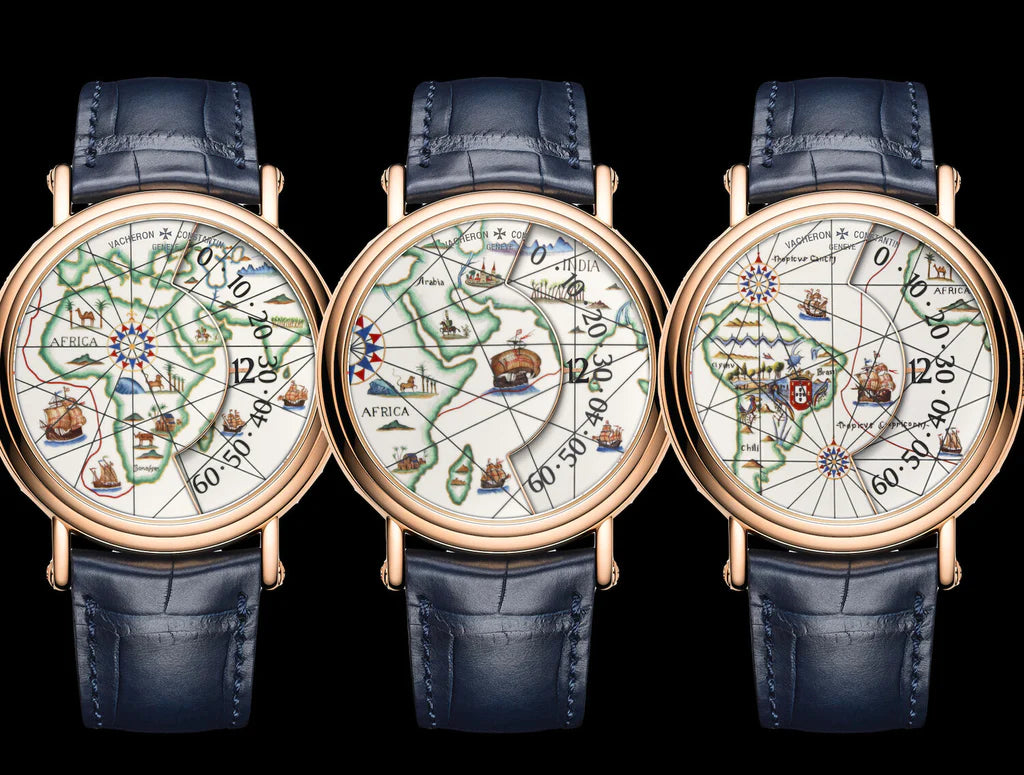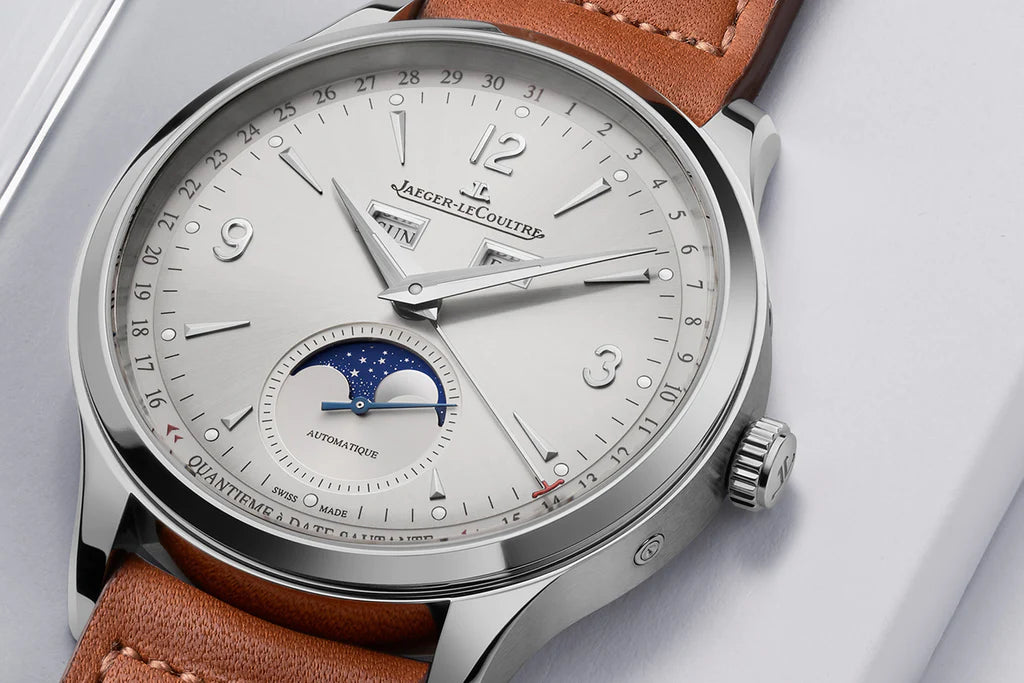

Visually, the watch dial is where the action takes place. It’s often the first thing people notice and can even have the power to swing a purchase.
While some watchmakers keep the dial (AKA the face) low-key, others use it as grounds to get creative. Just look at the bubbly Rolex Oyster Perpetual of 2023 and the complex design of the Duomètre Sphérotourbillon by Jaeger-LeCoultre.
10 popular materials for watch dials
Crosshair
A crosshair dial is crafted using thin, barely-visible vertical and horizontal lines that cross in the centre. The perfect formal watch with a vintage design, crosshair dials were a popular choice for mid-century dress watches. Today, watchmakers put modern and innovative spins on the traditional design.
Find it on:
- Omega Seamaster Pre De Ville
- Breitling Transocean

Enamel
Enamel dials date back to the beginnings of watchmaking. The material is actually a soft glass derived from silica, that’s mixed with other compounds to eventually become a hard-wearing substance with a durable, vivid colour.
Crafting a true enamel dial is a tedious process, which is why many watchmakers today replace the process with a lacquered dial that looks like enamel. Real enamel faces give off a radiant sheen and a rich, creamy texture for eye-catching levels of luxury.
Find it on:
- Seiko Presage SPB047
- Vacheron Constantin Métiers d'Art collection
-
Gilt
Said to be a lost art, no watchmaker today still manufactures watches with a true gilt dial. A weakness of vintage watch lovers, gilt techniques involve a thin layer of metal (which tends to make the features appear gold). It’s a lot of work for a subtle result, which is why most modern dials feature gold-coloured printing instead.
Technically, they are “gilt-tone” dials, rather than straight-up gilt dials.
Find it on:
- Rolex Submariner
- Tudor Heritage Black Bay
-
Guilloche
Traditionally, the guilloche method (also known as “engine turning”) involved hand-engraving the dial to create a decorative pattern - from waves to circular patterns and broken lines. Today, most watchmakers speed up the process with a machine. Not only does this provide a striking aesthetic, but the technique delivers better protection against wear and tear in comparison to a polished surface, as well as anti-reflective properties for better legibility.
Find it on:
- Breguet Classique 7137
- Patek Philippe Grand Complications Minute Repeater Reference 7040
-
Linen
Linen dials get their name because of their pattern, which resembles linen fabric. The technique cropped up in the 1960s, creating a finish that catches the light like other watch dial materials can’t. With an approach that overlaps crosshair and guilloche, the textile-like pattern is achieved using imperfect crosshatch engraving.
Find it on:
- Rolex Datejust
- Tudor Prince Oysterdate
Marquetry
The art of marquetry was around before mechanical horology itself. In a similar way to a jigsaw, the process involves using different shades of material, cutting them up into tiny pieces and fitting them together as a design. The materials used could be fabric, mother of pearl or precious stones, amongst others.
Find it on:
- Vacheron Constantin Mécaniques Sauvages models
- Hermès Slim d’Hermès Les Zèbres de Tanzanie
Meteorite
As the name suggests, a meteorite watch dial contains actual pieces of meteorites, space rocks that have fallen to earth (and could be billions of years old). A rare material that is difficult to work with, watches with a meteorite dial are usually made in small batches — and so are high-value pieces.
Rolex was the first manufacturer to use slices of meteorite in its watch dials, using the material to create completely unique dials with a natural crystalline pattern. No two Rolex meteorite dials are exactly the same, but they are some of the brand’s most high-value, collectable watches.
Find it on:
- Rolex Cosmograph Daytona
- Jaeger-LeCoultre Master Calendar

Skeleton
A skeleton watch dial exposes the inner workings - the skeleton - of the timepiece. It’s simply created with a transparent material (such as glass or sapphire crystal) that celebrates everything going on under the hood. A perfect choice for watch connoisseurs that appreciate the intricate mechanisms that power their watches.
Find it on:
- Audemars Piguet Royal Oak Openworked
- Accutron Spaceview 2020
Tapisserie
A tapisserie dial is defined by tiny squares in a waffle-like design. It’s achieved with a tool called a pantograph, which traces the design before engraving it onto the watch face. The AP Royal Oak leads the conversation when it comes to tapisserie dials.
Find it on:
- Audemars Piguet Royal Oak Chronograph
- Audemars Piguet Royal Oak Grande Tapisserie
Teaked
At its most simple level, a teaked dial is one that is engraved with vertical stripes. A highlight in Omega’s Aqua Terra line, the vertical stripes are said to mirror the teak decks of luxury yachts. Whether or not that analogy springs to mind for you, teaked watch dials are a classic choice that looks especially good on lighter tones.
Find it on:
- Omega Seamaster Aqua Terra
- Orient Star Standard-Date
Weird & wonderful watch dials
Tissot Seastar 2000 Powermatic 80 - Teal Dial
This Tissot Seastar takes inspiration from the blue-green dial trend of today, giving it a deep-sea treatment with wave engraving. The watch is designed to perform even in the extreme conditions of nautical sports, with large luminescent indices that aid legibility in water.
Seiko Presage - Matcha Green Dial
A limited-edition Presage model with a unique texture inspired by Japanese matcha tea powder. The concept originally came from cocktails created at Star Bar in Kyoto and in homage to this, the dial patterns echo the light refraction of a cocktail glass.
Grand Seiko SLGH005 - Birch White Dial
The SLGH005 represents a white birch tree forest in Shizukuishi, Japan, which grows just outside the Grand Seiko headquarters. The watch dial brings two textures together: a larger texture for wavy, bark-like features and granular imprints that add depth. The idea is to evoke the feeling of being in that forest, and to bring the wearer closer to “the true and eternal nature of time.”
Jaeger-LeCoultre Duomètre Sphérotourbillon
The dial of the Duomètre Sphérotourbillon is an ode to the complexity of the watch’s movement. Different counters on the dial display the functions, and have unique aesthetic codes that reflect the Sphérotourbillon. Overall, a sleek design places the emphasis on the tourbillon.
Glashütte Original Vintage Sixties
Glashütte’s Vintage Collection features bold, funky dials with textures taken from the brand’s very own archives. The dial that graces the Fiery Orange version has roots in the brand’s history - just after WW2 - projecting a rich, metallic colour for unmistakable 1960’s vibes.
Audemars Piguet Royal Oak Offshore Diver
The Royal Oak Offshore Diver line is bold in design. It’s the home of bright dials, including neon greens, yellows, pinks and oranges. A grande tapisserie pattern makes up the dial, complementing the hands to keep things elegant yet sporty.
De Bethune DB28 Grand Sport
The DB28GS features an electric-blue dial that proudly showcases the watch’s mechanisms. Bordered by blue relief Arabic numerals is a technical face and hand-smoothed titanium minute ring.
Rolex Oyster Perpetual 31, Oyster Perpetual 36 and Oyster Perpetual 41
Rolex unveiled new additions to its Oyster Perpetual line in 2023. The new dials reunite bubbles in colours introduced in 2020, with candy pink, turquoise blue, yellow, coral and green playing together for fun, creative designs.
Discover your dream dial at Trilogy
Visit Trilogy Jewellersin Mayfair, London, to browse our collection of luxury watches from brands like Rolex, Patek Philippe and Audemars Piguet.
Otherwise, call 0203 929 8227 to talk with our experts about our same-day sourcing service, where we can help you locate the perfect new timepiece for your portfolio.
TRILOGY ON YOUTUBE
Follow Trilogy on YouTube for regular updates and reviews of luxury watches and jewellery.

